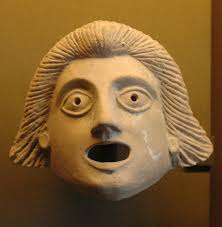More Culture Topics
- Ancient Greek Religion
- Greece Movie
- Greek Architecture
- Greek Art
- Greek Bible
- Greek Columns
- Greek Costumes
- Greek Culture
- Greek Jewellery
- Greek Key
- Greek Masks
- Greek Music
- Greek New Testament
- Greek Orthodox
- Greek Philosophers
- Greek Pottery
- Greek Radio
- Greek Religion
- Greek Sculpture
- Greek Tattoos
- Greek Temples
- Greek Theater
- Greek Tv
More Topic Categories
Related Destinations
Greek Masks
 Masks in Ancient Greece were important elements of the cult of Dionysus in Athens, most probably used during ceremonial rites. Very little information is known around this element and it is mainly drawn from few vase paintings of the 5th century BC. No masks have survived today, mainly because they were made of organic materials; the reason for this is that they were not meant to be kept for long periods of time; they were rather dedicated to the god after the ceremony was over. Examples of materials that were used for the creation of masks include linen, leather, wood and cork.
Masks in Ancient Greece were important elements of the cult of Dionysus in Athens, most probably used during ceremonial rites. Very little information is known around this element and it is mainly drawn from few vase paintings of the 5th century BC. No masks have survived today, mainly because they were made of organic materials; the reason for this is that they were not meant to be kept for long periods of time; they were rather dedicated to the god after the ceremony was over. Examples of materials that were used for the creation of masks include linen, leather, wood and cork.Apart from the cult of Dionysus, masks were also used in Ancient Greece in theatrical performances and they had been in use since the time of Aeschylus. They were mainly worn by the chorus, a group of twelve to fifteen actors that would take some part in the theatrical play and also become commentators on the action. They all wore the same mask, because the chorus was supposed to be one character, usually “the common sense” or the “public opinion”.
In open – air theatres such as the Theatre of Dionysus in Athens, the masks would cause a sense of fear and panic in the audience, especially because of their exaggerated traits. Moreover, it had a functional value, as the same actor could simply change masks and reappear in many different roles, without causing confusion to the audience; in fact, as there were only male actors in Ancient Greece, masks enabled them to take on female roles as well.
See Also:
 Athens Photos
Athens Photos
 Santorini Photos
Santorini Photos
 Crete Photos
Crete Photos
 Meteora Photos
Meteora Photos
 Corfu Photos
Corfu Photos



